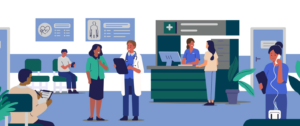3 Ways to Stop Profit Leakage and Optimize the Patient Revenue Cycle
By Chloe from Clearwave | June 1, 2023
It’s no secret that many healthcare practices are having trouble meeting their revenue targets. In fact, research reveals that 66% of practices missed revenue goals in previous years. It’s easy to understand why this is a continuing trend, especially given the challenges the healthcare industry faces today – rising labor costs, inflation across the board, patient turnover and an uncertain economy.
Profit leakage throughout the revenue cycle is a big factor impeding healthcare organizations from meeting their financial goals. While these revenue leakage issues are extremely common among practices, the good news is, they also are solvable with the right actions.
Here are three opportunities for improvement that will help you minimize profit leakage and create a scalable revenue cycle.
1. No-Shows and Appointment Gaps
No-shows can lead to patient attrition and associated revenue leakage. A recent study found that approximately 30% of patients with one or more no-shows don’t return to the same practice.
Patient no-shows may seem beyond your control – after all, it’s the patient’s responsibility to make it to a scheduled appointment. Studies show that on average, 52% of patients miss their appointments because they simply forget. Beyond forgetfulness, patients may have scheduling conflicts pop up or decide they no longer need an appointment. How easy do you make it for these patients to modify their appointments? Making patients pick up the phone to connect with a front office worker within your confined hours of operation is an extra step patients may neglect to take when they need to cancel/reschedule an appointment. When this happens, practices not only misses out on that particular patient’s revenue but also see appointment gaps that could otherwise have been filled with urgent, same-day or waitlist visits.

There are actions high-growth practices are taking to successfully decrease their no-show rate and appointment gaps. Implementing automated appointment reminders, via email, text or voice, is a strong first step to bringing in more patients and fueling patient loyalty. Yet, beyond the notification itself, it’s your approach to patient reminders and scheduling that can help you fill more appointments.
Within your automated patient reminders messages, provide patients with the option to modify their appointments to cancel, reschedule and book appointments easily, quickly and on their own terms. Additionally, find a scheduling solution that offers online and after-hours appointment scheduling and an automated patient waitlist to fill any last-minute gaps that occur as a result of patient appointment modifications (cancellations/rescheduling). Practices have seen 61% of their online bookings fill last-minute appointments.
This webinar conversation discusses how these digital scheduling tools are imperative to increasing patient acquisition and realizing revenue. See what high-growth practices implement.
2. Patient Write-offs
Just like any business, healthcare providers want to be paid for the services they render. Yet unlike other businesses, a practice only has a 30% probability of collecting payment once a patient leaves the office. Practices that have inconsistent point-of-service payment processes are at higher risk for write-offs and profit loss.
For example, many practices rely on front office staff to collect co-pays and past-due balances. These employees are not bill collectors, and with a busy waiting room, uncertainty around patient responsibility due and staff inexperience can lead to staff neglecting to drops in your collection rate. Another common roadblock to payment collections is a lack of awareness on the patient’s end about their payment responsibility. When patients don’t know they’re going to owe money, the chances that they will provide payment at their appointment significantly decreases – especially when treating underinsured or uninsured patients.
A patient revenue platform™ can set your practice up for success by automating patient collections – both co-pays and outstanding balances – during the digital check-in process, all without staff intervention. With digital tools for payment collection, you no longer need to rely on staff for collections – which often results in immediate increases in point-of-service payments. Digital patient revenue solutions also leverage real-time patient eligibility tools to provide practices with accurate patient co-pays and deductibles.
This recent conversation dives into how high-growth practices are collecting more from patients at check-in, including past due revenues, reducing non-payments altogether. Hear the steps they took.
3. Claims Rejections
Nearly 86% of mistakes made in the healthcare industry are administrative errors. Missing and incorrect patient information are two of the most common contributors to claims rejections. Accurate patient demographics, insurance and subscriber number information are all imperative to submitting clean claims and minimizing bad dept. When any one of these components is incorrect – the patient’s name is misspelled, their birth date is wrong or the patient ID/group/subscriber number is missing, for example – the insurance company can’t match the claim to the correct patient. As a result your practice will incur a rejected claim that must be corrected and resubmitted, extending your time-to-payment.

In addition to human error, front-end process complications such as insurance validation methods, also contribute to a high claim rejection rate. In fact, 29% of claims denials and rejections are due to inefficient front-end processes.
Forward-thinking healthcare practices are overcoming these common claims challenges by:
- Implementing patient self-service scheduling and registration, which removes manual staff data entry from the equation and the risk of human error along with it.
- Ensuring eligibility verification is done in real-time, which helps practice collect payment at every check while saving staff hours in a day.
- Automating data capture and reconciliation processes, which helps your practice submit cleaner claims and save money with fewer resubmission costs.
Having these upfront automated processes in place to capture and validate patient information is critical to reduce downstream errors, minimizing claim rejections and speeding up time-to-revenue. What does that look like for your practice? This conversation discusses how to elevate your front-end patient processes to streamline back-end billing operations.
Optimize Your Practice Revenue Cycle
All of the above challenges – appointment gaps, patient write-offs and claims rejections – can be reduced by optimizing your front-end approach to patient engagement and revenue. High-growth healthcare practices rely on digital patient revenue platforms to help them make it happen. At a time when every dollar counts, minimizing profit leakage and building a strong revenue cycle are critical to meeting your financial goals.
Our recent webinar, “4 Ways to Make Your Revenue Cycle Pay You in Strides” explores these areas of improvement in depth and provides bonus check-in efficiency tips that will help you unlock new revenue streams. Watch it today to learn how to optimize your revenue cycle and earn more for every patient. Contact us today to find out how Clearwave’s patient revenue platform can help in the process.
Recommended for you
Related Posts
How Poor Insurance Verification Reduces Profits for Cardiology Practices
Reading Time: 4 minutes In the world of cardiac care, cardiology practices are grappling with a myriad of obstacles to maintain their financial health….
How to Circumvent Rising Healthcare Practice Costs to Fuel Profitability
Reading Time: 5 minutes By Chloe From Clearwave | June 26, 2024 Specialty practices are operating in an unprecedented time of rising healthcare costs….
Long-Lines Giving You Blurry Vision?
Reading Time: 4 minutes Clearwave & Thomas Eye Group’s 10-Year Partnership Puts Patients First By Blakely Roth | June 18, 2024 In an era…




